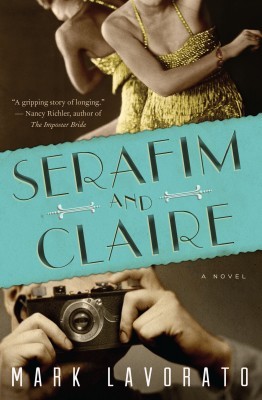Mark Lavorato’s delicious new novel, Serafim and Claire, opens with two characters on the brink of life-altering decisions. Claire lies in her shabby apartment in Montreal in the dead of winter, her body fighting a deadly fever, the cause of which is unknown to us. Serafim sits in a tavern in Oporto, Portugal, stunned by some news we are not privy to, drinking his way to numbness. Who are these people and what has led them to these fateful points? Inherent in the title of the novel is the promise that the decisions these disparate characters make in the next few moments will put them on an inexorable path towards one another.
The majority of Serafim and Claire unfolds in the rich and vibrant world of Montreal in the late 1920s. The city is a hotbed of social change – we meet artists and agitators, thugs and moralists, nuns and suffragettes – and the title characters are trying to find their places in it. Serafim, a poor immigrant photographer, is fascinated by the new candid style of photography that is all the rage in Paris but that hasn’t caught on yet in the New World. Claire, a gifted dancer stuck in the cabaret scene, will use any means to overcome her lack of social connections and get herself into a respectable dance troupe. Both are driven by an all-encompassing desire to discover and create.

Serafim and Claire
Mark Lavorato
House of Anansi Press
$22.95
paper
336pp
978-1-77089-365-8
Lavorato’s pacing is excellent and his characters deftly wrought (of a future suffragette, he writes: “[she] wasn’t exactly sure how one formed an opinion, though she became increasingly certain that an opinion was an important thing to have”). But what makes Serafim and Claire such a delight is his lush description. Lavorato brings Montreal in the Roaring Twenties to life, from the stately mansions of Westmount to the raucous burlesque theatres in Le Red Light to the echoing halls of the Hôtel-Dieu hospital, staffed with judgmental nuns.
The book has clearly been painstakingly researched, but Lavorato has resisted the ego-driven impulse to put all his background work on display. Instead, he curates his historical details with care. Every reference that is made, from the efforts of the Montreal Local Council of Women (a coalition of primarily Protestant Anglophone wives “bent on weeding out the sordid vice of prostitution from the city’s streets”) to the tragic Laurier Palace Theatre fire that left seventy-eight children dead, is presented because it is an integral part of the narrative.
Readers familiar with modern Montreal politics will catch themselves thinking, as they read, “plus ça change, plus c’est la même chose.” Serafim and Claire may be set eighty-five years ago, but many of the themes, from bribery of city officials to the prejudicial treatment of cultural minorities, are relevant today. One cannot help but wonder if they will be any less so a century from now. mRb






0 Comments